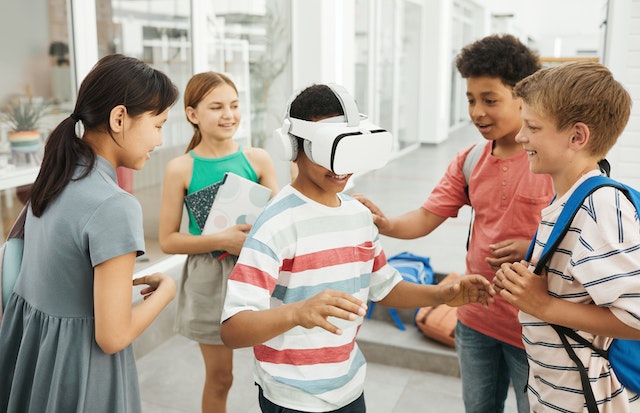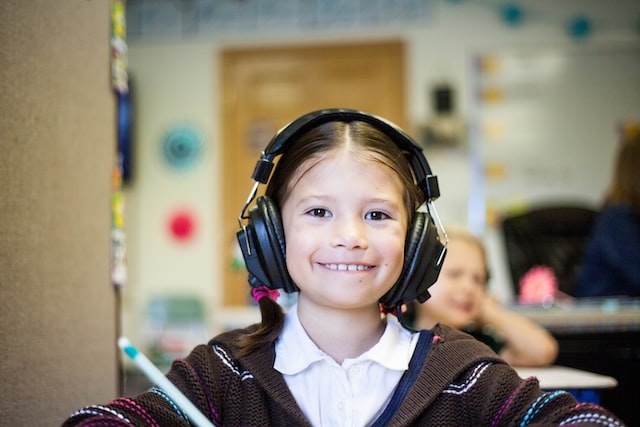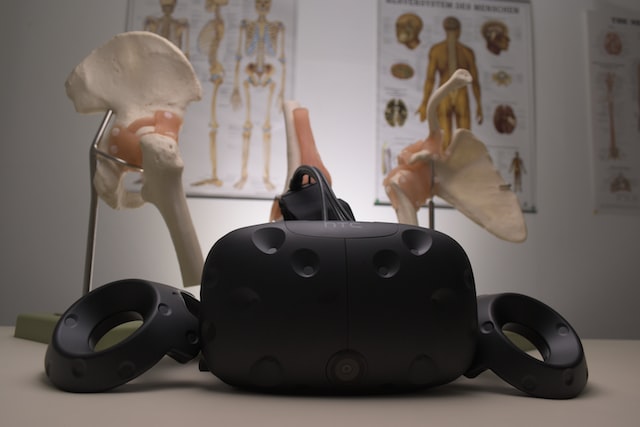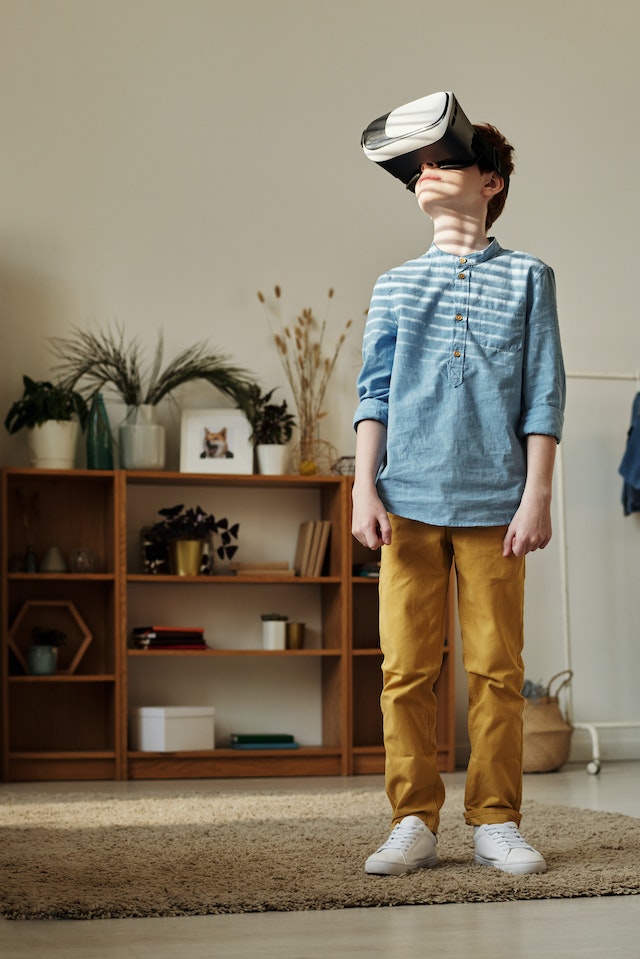
5 Ways Virtual Reality Enhances Learning
March 14, 2023
Not so long ago, Virtual Reality (VR) is something one can only see on the big screen — a concept made popular by sci-fi movies. These days, however, they are far from just being works of fiction. As technology continues to advance, the past few years have also seen VR becoming more mainstream.
Initially, VR was introduced as a powerful tool to enhance the experience of those involved in the gaming industry. Over time, however, as more people saw its potential, more industries have delved into exploring its many possibilities. Thanks to the “life-like” experiences that the technology offers, more industries have started to incorporate it into their respective processes.
The field of education is no exception. The emergence of smart VR schools in recent years showcases the many ways that VR technology can be incorporated into the learning setting. With the immersive experience it offers, VR is making learning more fun, involved, and interesting. Many institutions are even starting to recognize the many benefits VR can offer for students with disabilities. Read on as we will explore the many ways VR is making waves in education.
Practical and risk-free training
VR is known for its simulated environments. In the traditional classroom setup, students are often taught various concepts and theories, followed by practical activities to allow students to apply what they have just learned. Unfortunately, there are limitations to this in the usual school setting, particularly in the available resources to execute such training. As such, students are only likely to practice what they’ve learned a few times considering the constraints involved.

With VR however, it is more than possible for students to practice what they’ve learned in a virtual simulation as many times as they need to. VR simulations also provide students with a safe and secure setting where they can practice any unfamiliar skills without having to worry about getting injured or causing injury to others. It’s no surprise how the technology is utilized by certain industries as a useful tool for hazardous work training. This risk-free environment in a VR simulation allows students to polish their skills because they can afford to make mistakes and ultimately, learn from them.
Remote learning and accessibility
Thanks to the internet, the world these days is becoming a much smaller place. Connecting with people from across the world is more than possible. VR technology only enhances that. Through internet connectivity, VR makes it possible for students to learn no matter where they are. Students can even learn right from their homes and still experience the full classroom treatment through virtual reality. As such, VR is becoming a fantastic tool for homeschooling.
VR also promotes accessibility for learning. It doesn’t matter where you are in the world, the simulation offered by the VR technology remains the same wherever you are accessing it from. When barriers like distance are broken down, there is no stopping anybody who wants to learn. With this, VR can be used as a tool to equalize opportunities for education and learning. With its current trajectory, the technology is on the right track to transform education and introduce a less conventional approach to teaching.
Medical training and simulations
Another area that is greatly benefitting from the use of VR in education is medical training. Many hospitals and medical colleges are putting more effort into investing in VR technology for medical programs and incorporating it into their learning processes. Medical students need to hone their skills in how to handle a variety of scenarios from simple surgeries to complex operations. The immersive and interactive world of VR is the perfect platform to ensure that this is exactly what they are getting.
In traditional training settings, students cannot afford to make errors, especially when a patient’s life is on the line. With a VR simulation, however, students are free to explore every single possibility out of every scenario. They can afford to make mistakes along the way. By being able to perfect their skills through trial and error, medical students will feel more confident that by the time they graduate, they are equipped with critical practical skills to make a difference once they start interacting with real-life patients.

Virtual field trips
Perhaps one of the most popular applications of VR in the education sector, virtual tours, and field trips make it possible for learners to go to places that would otherwise be physically impossible for them. Field trips are crucial in the learning process as they reinforce what students have learned in the classroom. However, the recent pandemic has made educators realize how it is not always possible to facilitate in-person tours and trips for students.
When students are unable to step out of their homes or classrooms, VR can be used as an alternative learning tool instead. With just a VR headset, students can travel to places all over the world and even experience and immerse themselves in the cultures and traditions of these places — all without having the need to go anywhere. From doing a virtual tour of the Louvre, climbing up the Eiffel Tower, exploring the Sahara desert, or even taking a trip to space, nothing is virtually impossible with VR.
Inclusivity for students with disabilities and special needs
Students with special needs and learning disabilities will never be able to learn the conventional way. The usual medium of instruction and the use of textbooks and worksheets are never going to be as effective for them as they would be for regular students. The use of VR in special education, however, is a different story.

With VR, it is possible to work past a student’s disability and allow them to discover the joys of learning. Special needs students always learn at a different pace from their classmates in a traditional classroom setting. However, with VR technology, their learning deficiencies no longer have to hamper their education. Teachers can utilize VR technology in creating simulations that are tailored-fit to a student’s specific capacity, interests, and learning needs. When students with disabilities no longer have to be pressured to keep up with the rest of the class, they will discover a new appreciation for learning that is not possible with the conventional way of teaching.
Technology harnessed right
The many strides that VR is making in various industries and most notably, in education, is further proof that when harnessed right, technology can be a force for good. While it is true that research to quantify the many benefits of the technology in this sector is still few and far between, it is also undeniable that it has the potential to transform education in the most positive ways possible. As technology continues to evolve and more advancements are introduced in the field, it is not surprising to see how the rest of the world has shifted its gaze to VR for the possibilities it can pave the way for.
Technology in learning can be a great equalizer. In learning settings involving students with disabilities and special needs, technology can help bridge the gap to ensure that nobody gets left behind. This is where virtual reality (VR) technology can make a huge difference. With such a tool at their disposal, teachers will be able to tailor-fit their instructions and lessons based on the learning needs and capacity of the students. As a result, they can empower students with special needs and make them interested and motivated to learn.
Many educators are often faced with the challenge of how to include special needs students in the many classroom activities. When students are struggling with certain subjects, however, keeping up with these activities can be very challenging. Technologies like VR make it possible for educators to differentiate which students need an extra helping hand in the classroom. With the tool at hand, it is possible to make slight tweaks and changes to assignments to ensure that they are well within what the students can grasp. When used effectively, digital technology can boost engagement in classrooms.
Making use of assistive technology
In traditional learning settings, educators will often rely on the use of worksheets and textbooks as the main medium of instruction. While this may work in classrooms when every student is at the same level of learning capacity, this can be a different story in learning settings where there are students with disabilities. Oftentimes, this teaching method will be unsuccessful, causing the special needs students to get left behind as a result.

In recent years, many educators have employed the use of assistive technology to augment learning settings where students with disabilities are present. This involves the use of a variety of tools from computer software and communications tools to tablets and VR. In learning settings where students with disabilities are present, VR technology has the potential to make a huge difference. It is especially useful for students with learning disabilities, behavioral disorders, sensory impairment, severe cognitive disabilities, and attention deficit disorder.
Breaking down the physical obstacles
Oftentimes, kids with physical disabilities are limited when it comes to what they can do and participate in when in class settings. However, with VR, it is more than possible for them to engage in other activities they would never be able to in traditional learning settings. There is no limit to what one can do in the virtual world. So, even physical limitations such as being in a wheelchair cannot hold back students from experiencing things they would not be able to in the physical world.
In classroom settings, physical limitations can make it challenging for students to grasp certain ideas and concepts being introduced in the classroom. Through the virtual environment, however, there is a way for them to access learning opportunities that would otherwise be out of their reach. Through the simulated world of VR, students can experience virtually anything from swimming to surfing to skiing to anything that the technology can simulate. And that can be a very empowering experience.
Support for students with special needs
VR can offer special needs students the support they need to boost their motivation to learn more. Oftentimes, it can be disheartening to continue learning when you are limited by so many things and you’re learning at a significantly lower pace than the rest of the class. With VR, students with special needs can enjoy the full advantage that the VR learning setting can offer.
Through simulated lessons, they will discover that learning is more fun when they do not have to be limited by their disabilities. For kids with special needs that are experiencing some challenges with their communication skills, the interaction they can learn through the VR world can be a game-changer. This is especially useful for kids with hearing issues and special needs. Educators may even be able to promote social contact through a VR headset when teaching kids on the spectrum.

Learning in a secure setting
It’s quite common for students with special needs and disabilities to find it challenging in social settings and the classroom is no exemption. Because of their limitations, many might feel awkward inside the classroom setting. Some students with disabilities would often withdraw to a corner as their physical limitations already make them feel isolated from the rest of the class.
With VR, students who are mentally or physically challenged will be able to learn in a setting that is secure, safe, and relaxed. The simulated world of virtual reality offers them a safe zone where they do not have to feel awkward about their disabilities. When students can learn in such an environment, they will feel more motivated as learning is now associated with a positive experience instead of the usually awkward encounters they are used to.
Promoting independent learning
VR is known for its experiential and immersive learning experience. When students can interact with the concepts, lessons, and theories being presented, they can have a better grasp of what is being taught. When kids are no longer reliant on a teacher to facilitate instruction, they get to learn at their own pace. This does away with the pressure to keep up with everybody else.

When every student can’t perform the same activities, VR can be used to provide students with different activities based on their capabilities. What’s even better is that this can be done discreetly, so students won’t have to feel embarrassed about doing something different from the rest of the class. VR allows them to do that without having to feel embarrassed about it.
In the VR setting, learners will have more freedom to take up lessons at a pace they are more comfortable with — something that is very necessary for students with disabilities. The fact that one can also just revisit lessons and subjects at any time means they can take their time to go over concepts that they have not wholly grasped the first time as many times as they need to. Some special needs students may require revisiting topics more than a few times to fully grasp a lesson. It is also for these reasons that VR is transforming homeschooling.
A promising development
With VR in schools, students with special needs can benefit from progressive learning techniques that are conducive to their capabilities and takes into consideration their limitations. Virtual reality makes it possible for students to go beyond the limitations of their four-walled learning environment. Whether they want to explore the Eiffel Tower, visit the pyramids, learn what happened on D-Day, or even visit space, it is possible with VR. For students who have always been grounded by their physical and mental limitations, this is an empowering experience. VR in special education is a step in the right direction. As the technology progresses and evolves, it is only a matter of time before it becomes the norm in any learning setting.
Only a few years ago, virtual reality (VR) is just a concept that you can see in sci-fi movies. When the first virtual reality headset was introduced to the market, people started to believe that it could possibly be more than just a concept on the big screen. Luckily, the idea is no longer as hard to grasp in recent years. After all, we are in an era where people communicate with smartphones where talking and seeing people in real-time is possible.
Today, the VR and AR industry is one of the fastest-growing markets in the world. With a revenue of $16.04 billion in 2020, the projection for the industry for 2023 is pegged at $31.12 billion. That is expected to almost double by 2027. These impressive numbers have more to do with how the industry has really captivated the global audience.
The fact that the technology is potentially feasible for almost every industry out there imaginable just adds to this unwavering interest. While gaming remains the top industry where VR is making waves, education is coming in at a close second. With the promise of immersive experiences, it’s no surprise how many educational institutes are adapting VR learning into their respective curriculum as well as the introduction of VR schools in the scene. Read on as we explore how VR is influencing the future of learning.
There’s a prevalent belief that education is one of the fundamental human rights — that everybody should get equal access to it no matter where they are in the world, their race, country, or color. Unfortunately, this isn’t really what’s being reflected in reality. Most of the time, students are unable to pursue higher learning because they do not have access to the necessary knowledge source.

VR learning is expected to help bridge that gap. Through the technology, students who are prevented from pursuing higher learning via the traditional way can now get access to any concept, subject, or course they want to learn. With the recent global pandemic, people realized that learning does not have to be confined within the four walls of a physical classroom.
What’s even better is that VR elevates the learning experience. Where the usual distance learning modes involve video calling and virtual classrooms, VR makes the learning experience more realistic. Through its simulations and immersive setups, learning becomes more appealing and interesting to the students.
Medicine and engineering — two of the hardest subject out there, are known for requiring constant practice. Mastering the field requires more than just talent. In fact, a good chunk of what learners in these fields need is constant practice. This means that learners need to be immersed in various actual real-life scenarios to acquire real-world skills that they can then apply once they start practicing the field.
In traditional learning, medical students would need to spend a good chunk of their time in controlled environments to master their field. From dissecting the various parts and organs of the human body to performing complex operations, all these require long hours of practice and not to mention laboratory equipment and resources to carry out.
With virtual reality, however, this is made so much easier. As VR technology can recreate anything about the human body from its biggest to its most intricate organs, students can practice anything about the human anatomy as much as they want. The technology even allows for the creation of all sorts of hypothetical situations, which allows students to test their skills, knowledge, and response to these situations.
They can also carry out and repeat experiments as many times as they want. After all, everything they need will be in the virtual setting. Concerns about resources, tools, and equipment will no longer come into play as virtual setups can be repeated as many times as a learner wants without incurring additional costs.

VR is widely used in gaming as its realistic environment and responsiveness keep players hooked. However, these very same attributes make it as useful in the field of education. With the technology, it is now possible for educational institutions to come up with courses that feature not just topics that are fully animated but are interactive as well.
With the technology, it is possible to gamify the different learning exercises to make them more engaging to the students. With gamification, teachers now have numerous creative ways to make instruction livelier and more fun. Exercises and quizzes can now be gamified, making it easier to impart knowledge to learners in a manner that they will find more interesting.
Aside from benefiting those engaged in distance and virtual learning, VR is also transforming homeschooling setups. Gone are the days when learners are faced with boring modules and reading materials. VR learning, with its gamification features, now makes it possible for students to enjoy the learning experience and stay engaged and captivated throughout.


In many traditional classroom settings, it’s quite common to see students who are having a challenging time interacting with their peers. Different people have different social skill levels, after all. VR learning allows individuals to hone their social skills. Since the VR environment allows users to set up hypothetical situations, it is possible to hold conversations and polish one’s communication skills in a safe setting.
In addition, educators can set courses up where learners are encouraged to collaborate and work with other virtual learners. Designing coursework to involve incorporating different inputs from different individuals will teach students how to interact with each other, improve their communication skills, and hone them to be better team players in group settings.

Oftentimes, many people get discouraged from pursuing a higher level of education, especially if the subject is taught in a language that they are not very proficient with. While English is considered a universally spoken and understood language, there are still certain parts of the world where people may struggle to hold conversations with the language.
VR technology, however, eliminates that problem. With VR learning, it is possible to implement different kinds of languages into the software. This means that despite not speaking the mother tongue of the coursework you are interested in, you will still be able to understand everything as there will be automatic translations of what is being taught. With traditional learning, moving to a different country to study would mean having to learn the language. With VR, you don’t even need to leave your country to study. And you won’t even need to learn the language anymore.
It is quite impressive how much VR technology has accomplished since its inception. What’s even better is how the technology is still evolving and for the better! With education being considered the ultimate equalizer, modernizing how learning is coursed through virtual reality is expected to open more doors of opportunity to people who used to not have any in the past. At its current rate, it is safe to say that the future of education is even brighter with VR.
In the past decade, virtual reality (VR) emerged as one powerful tool that educators can harness to allow students to experience a more immersive, engaging learning experience. Gone are the days when education means getting confined in a four-walled classroom, sitting down, and listening as a teacher discusses the lesson in front. Today, many schools are adapting the concept of VR education and are learning how much it is helping students grasp lessons better than the traditional approach.
VR’s benefits go beyond the traditional learning setup. Students who are being homeschooled have also discovered how much beneficial virtual reality is in their understanding and grasping of the many concepts they are learning. With how VR allows users to expand their perception of things that are typically not accessible or discernible, it is hardly surprising how much the technology has positively impacted learning at every level.
What is truly impressive about VR is how easily and effortlessly it can transport users to faraway worlds without really needing to move an inch. With VR, concepts are no longer just concepts. Students can easily see a visualization of these concepts while also getting an idea of how they are applied in the real world.
As such, learners get a well-rounded understanding of how things apply in real life. This is even more useful when studying concepts in STEM. The possibility of visualizing concepts and subjects not only paves the way for better understanding but makes learning so much more interesting as well. Below are some of the ways virtual reality learning has transformed homeschooling.

Virtual reality makes it possible for students to experience things that are just not possible by just poring through their homeschooling materials. A VR headset is all that one needs to get transported to places, environments and settings that would otherwise be impossible for them to get to. Being able to visualize what you are trying to learn is more effective than just mere theoretical learning. As such, students become more engaged and immersed in the subject.
For instance, if you are interested in how things unfolded when settlers first came to the American shore, you can get transported to the day this happened and see things for yourself. More importantly, you don’t just get to visualize it, VR technology allows you to experience it.
However, parents do need to be more discerning about the things that their children are experiencing while getting homeschooled via VR technology. Making sure that the experiences are appropriate for their age level is essential. VR is highly immersive and ensuring that what your kids are learning is age-appropriate is critical in ensuring that the technology is utilized responsibly.
When it comes to learning, students prefer to watch something as opposed to just hearing it or reading it. Regardless of age, students tend to favor computer-based visualizations and animation. This is exactly what VR homeschooling offers. Instead of just throwing a book of concepts to the learners, they get to see, visualize, and experience the lesson instead. As such, it is easy to keep them interested throughout.
Since VR technology also allows for interaction, students don’t just get to learn faster, they get to retain what they have learned as well. With VR, things that they’re never going to experience in the real world become tangible. This improves their overall motivation, making them even more passionate about studying and learning more.
What VR offers is an immersive learning experience where students explore subjects, concepts and theories that traditional teaching methods are unable to. VR technology is known to incorporate gamification in its learning process. This is the addition of game design elements and mechanics are added to the learning process. Immersive and interactive, VR learning mimics virtual games, making the learning process fun.
Games often have a feedback and reward system that motivates players and keep them hooked. VR learning can use this system to provide learners with instant feedback as well as rewards for completing tasks, reaching milestones or achieving certain goals. Rewards can be unlocking new content or levels. It could also be in the form of virtual badges.
In addition, games are known for having engaging narratives that keep players hooked. The same can be applied to VR in homeschooling. The technology can be harnessed to use storytelling to keep learners captivated. For example, a history lesson on the American Revolution can be turned into a VR game, where the student plays the role of a colonial soldier and fights in key battles. These take learning to the next level and make the experience less of a requirement but something more fun that students can look forward to.

Traditionally, homeschooling has relied heavily on textbooks, online courses, and educational videos. However, these methods may not always provide a hands-on learning experience, which can be critical in helping students understand complex concepts.
With VR technology, students can experience simulations of real-world scenarios, which can help them understand concepts better and make learning more engaging and interactive. Students will be exposed to a more engaging learning approach compared to passive traditional ones.
For instance, students studying the human body can better explore the different systems, organs, and parts of the body. When learning about history, VR allows students to not only visit historical sites but to even check out museums or go on field trips to experience things first-hand — virtually, of course. Students can now experience historical events as they took place, making learning history more interesting and fun.
VR can engage multiple senses for a more holistic learning experience. This approach is based on the embodied cognition principle, which suggests physical experiences are better processed by the brain. In a VR learning setting, students won’t just see and hear experiences, but in some cases, touch what they are seeing and experiencing. This immersive experience can significantly enhance their understanding of the subject matter. The use of VR in learning is particularly beneficial for subjects that require hands-on experiences, such as science, engineering, and art.
The use of sound in VR is also a significant factor in providing a comprehensive learning experience. It can be used to enhance the immersive quality of the VR environment to make a more engaging experience. Recently, the use of touch is being introduced in VR technology and is looking quite promising. When harnessed right, VR developers can effectively create simulations incorporating a sense of touch to take learning immersion to the next level.

The pandemic has brought to the fore the many benefits of homeschooling. However, keeping learners interested in the lessons has remained a challenge, especially when they are learning on their own and not in a classroom with other similar-aged students. As homeschooling sometimes makes students feel isolated not just from other kids but also from the rest of the world, virtual reality learning opens new worlds of possibilities. With the engaging, immersive and more fun experience it offers, it is hardly surprising how more people are incorporating the technology into their homeschooling curriculum.